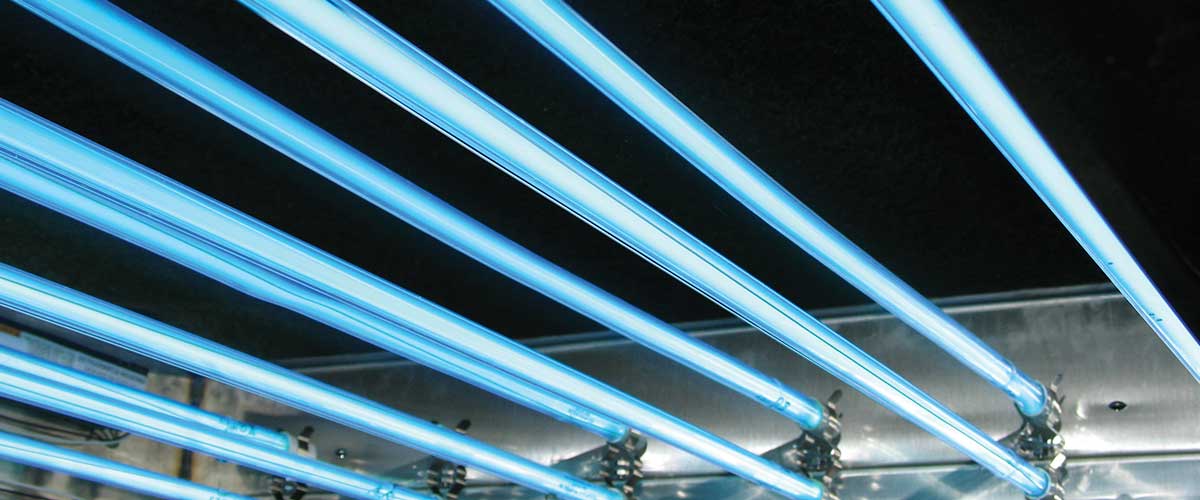Explanations & History of UVC Systems...
What Is UVC? - Ultraviolet light is electromagnetic radiation with wavelengths shorter than visible light. UV can be separated into various ranges, with short range UV (UVC) considered “germicidal UV.” Short-wave ultraviolet radiation, in the “C” band (200 to 280 nanometers) has been used for over 100 years.
How Does UVC Work? - UV light in the form of germicidal lamps has been used since the late 1800s to kill the types of microorganisms that typically cause indoor air quality problems -- bacteria, mold, yeast, and viruses.
At certain wavelengths UV is mutagenic to bacteria, viruses and other micro-organisms. At a wavelength of 2,537 Angstroms (254 nm) UV will break the molecular bonds within micro-organismal DNA, producing thymine dimers in their DNA thereby destroying them, rendering them harmless or prohibiting growth and reproduction. It is a process similar to the UV effect of longer wavelengths (UVB) on humans, such as sunburn or sun glare. Micro-organisms have less protection from UV and cannot survive prolonged exposure to it. For a list of Kill Factors for common Microbes Click Here
UVGI Systems - A UVGI system is designed to expose environments such as water tanks, sealed rooms and forced air systems to germicidal UV. Exposure comes from germicidal lamps that emit germicidal UV electromagnetic radiation at the correct wavelength, thus irradiating the environment. The forced flow of air or water through this environment ensures the exposure.
1900 to 1930s
Finsen Lamps - Niels Ryberg Finsen (1860-1904) is first to employ UV rays in treating disease. He is awarded the Nobel Prize for Medicine in 1903. He invents the Finsen curative lamp, which was used successfully through the 1950s. UVC is used to disinfect the municipal water supply in Marseille, France, in 1908.
In the 1930’s, Westinghouse Electric Company R&D engineers and scientists developed and patented the first commercially available ultraviolet lamps. They are used primarily in hospitals.
The first products were simple compared to modern-day technology, but they were very effective and initially were sold in conjunction with water filters to the U.S. Department of Agriculture to disinfect surface drinking water sources used by Arizona agricultural workers.
1945 to 1960s
Broad Market Acceptance of UVC - After World War II, UVC is used for sterilizing air in hospitals, kitchens, meat storage and processing plants, bakeries, breweries, dairies, beverage production, pharmaceutical plants, and animal labs -- anywhere microbiological contamination is a concern. Typically a beam of UVC is directed across the ceiling of a room. During the 1950s UVC is incorporated into air handling equipment. It becomes a major component in the control and eradication of tuberculosis (TB).
Move Away From UVC - During the 1960s, concern about microbes lessens with the introduction and increasing availability of new drugs and sterilizing cleaners. As mechanical ventilation becomes more popular, UVC performance suffers due to the lack of effective UVC performance in cold-air settings.
1970 to 1990s
Technological Improvements - In the 1970’s and 80’s, concerns over chemical use and improvements in UVC bulb manufacturing caused more organizations and companies to revisit UVGI. In the early 1990’s, UVGI was pioneered into significant water treatment processing for municipal systems as well as for treatment of swimming pools.
The introduction of UVC into HVAC systems is pioneered in 1996. Recent technological advancements have made it possible for companies to produce high-output ultraviolet germicidal devices further improving efficiency and effectiveness.
The 21st Century
Rethinking the Mechanics of UVGI - Prior to the introduction of the GreenZapr/miniZapr, the single method for UVC treatment was to pass the medium (water/air) across the UVC apparatus. By solving the portable power question and designing proper safety and efficiency controls, the GreenZapr/miniZapr allows for mobile sterilization. The miniZapr further effects mobility by consolidating all the necessary UVC components into a small, lightweight package.
Specialized UVC Bulbs, Light Modules, and Controls - The bulbs used in the GreenZapr are a specifically developed, high-intensity mercury-vapor lamp with a protective Teflon® coating to protect the bulbs and encase the glass during breakage.
Each light module on the GreenZapr utilizes a reflector made from spectrally polished aluminum, yielding a UVC reflectance of 73%. The combination of the bulb and reflector allow for a significantly greater amount of directed energy.
The GreenZapr is equipped with a number of important safety features including an motion shut-off and light-bed lift shut-off. The Central Control Module monitors and measures power so the lights operate at optimal voltage.

